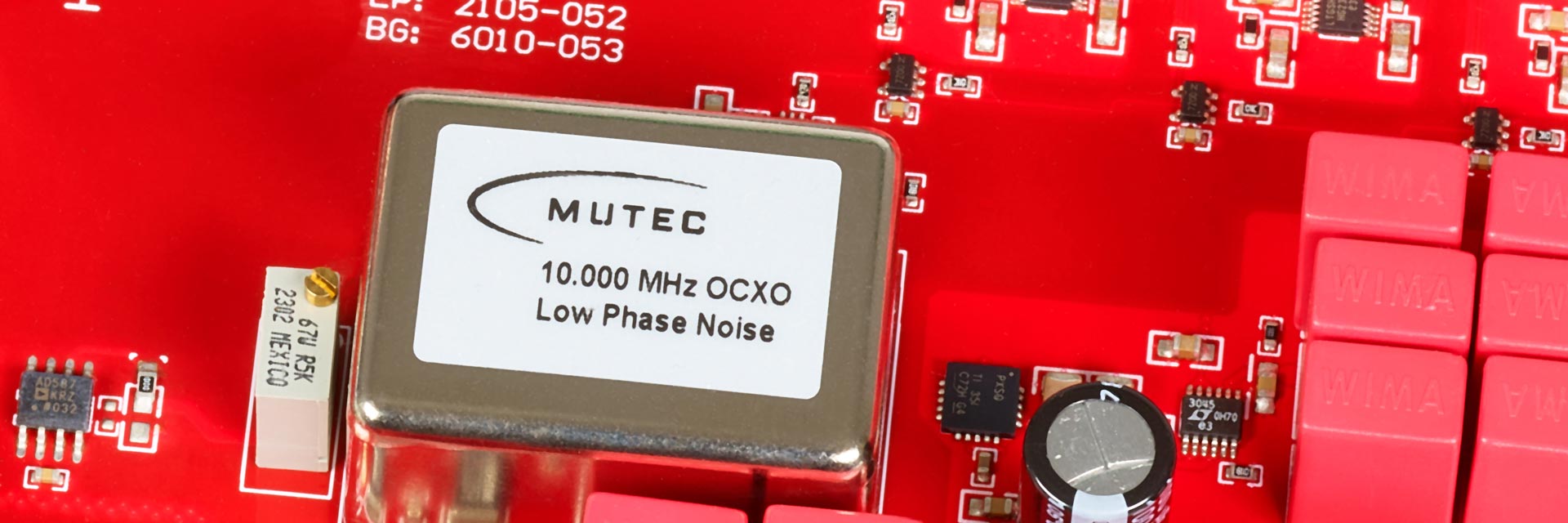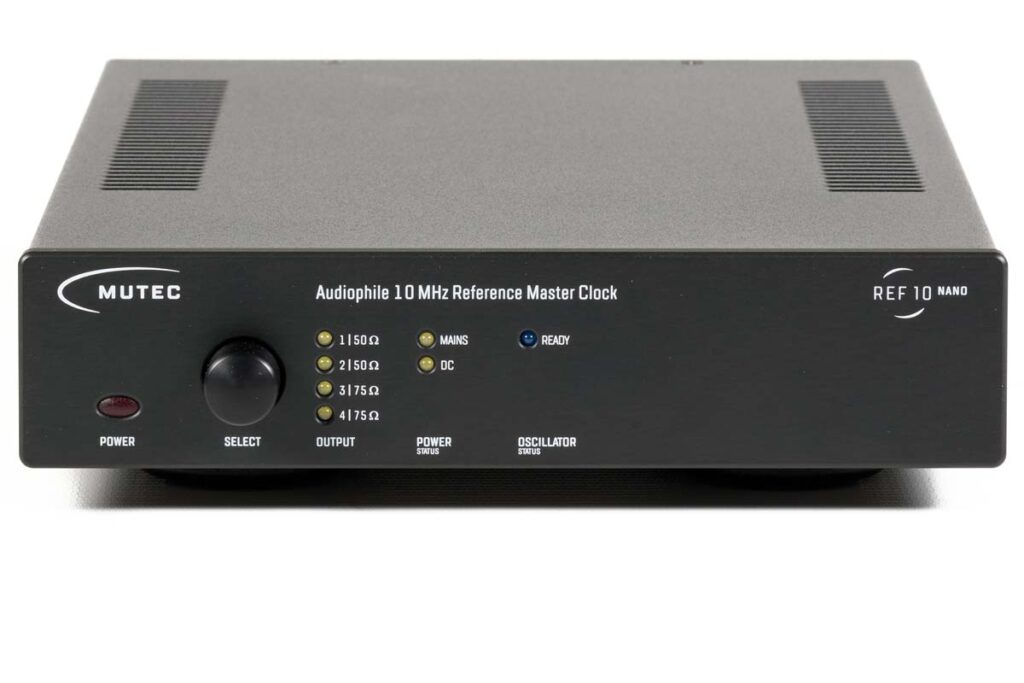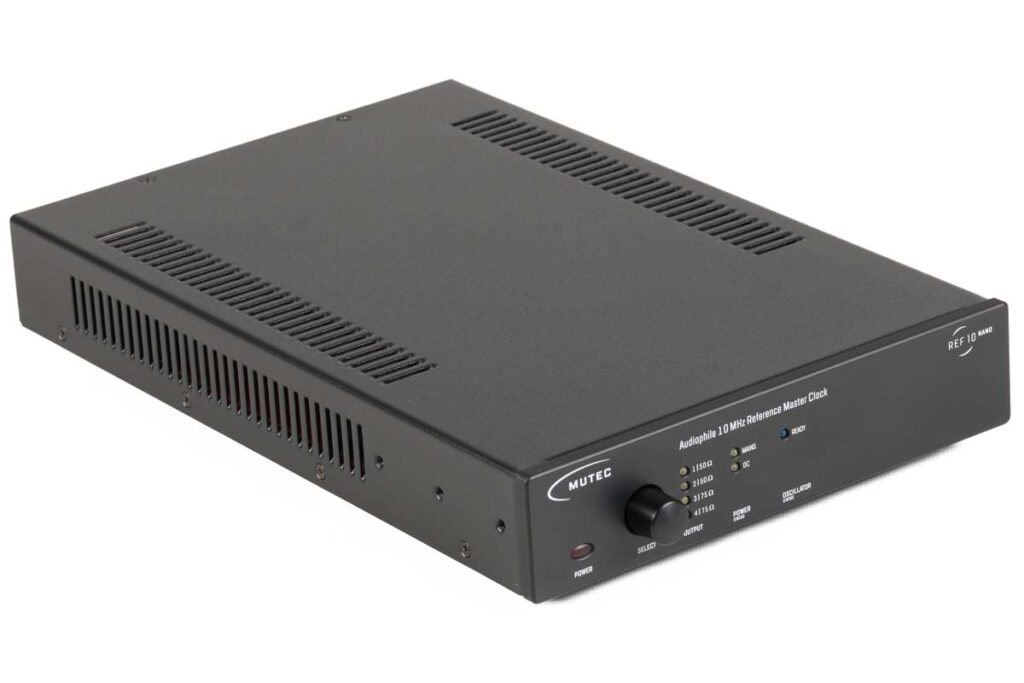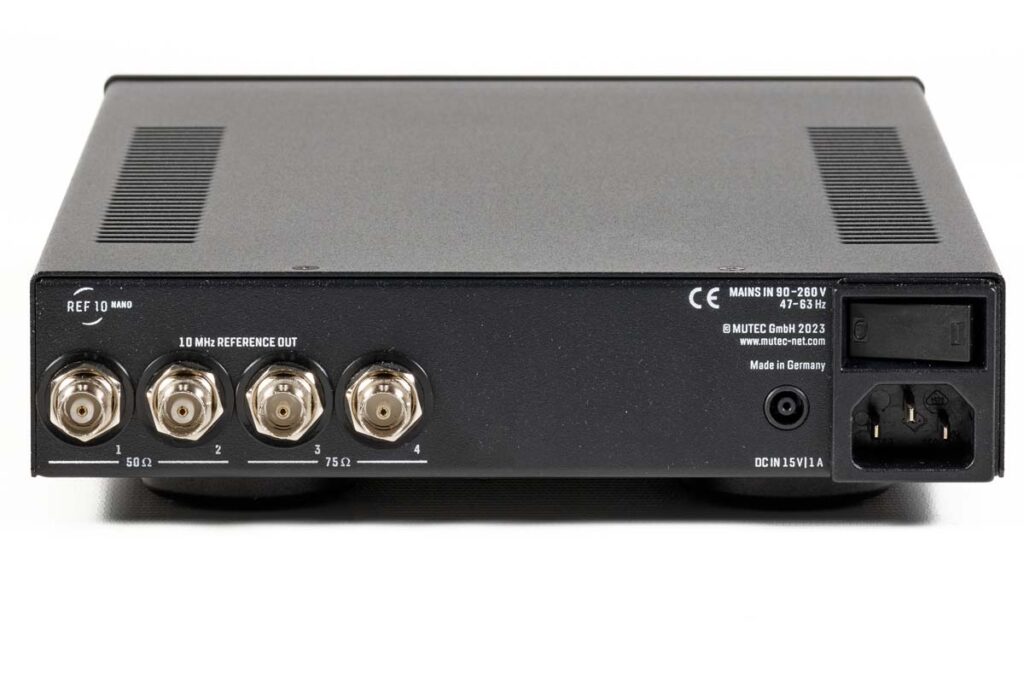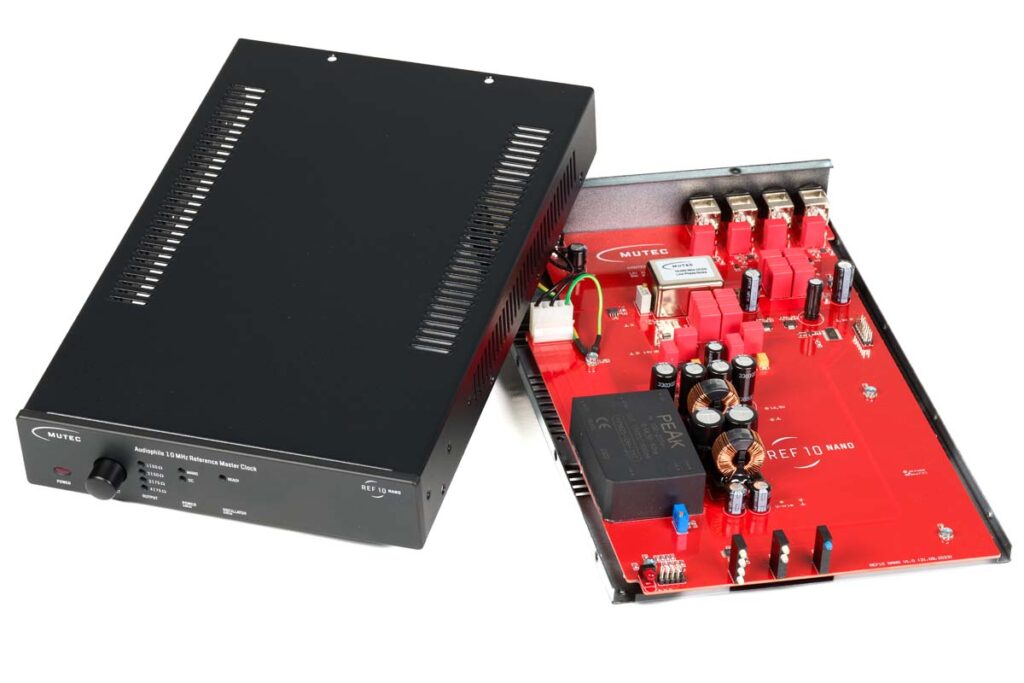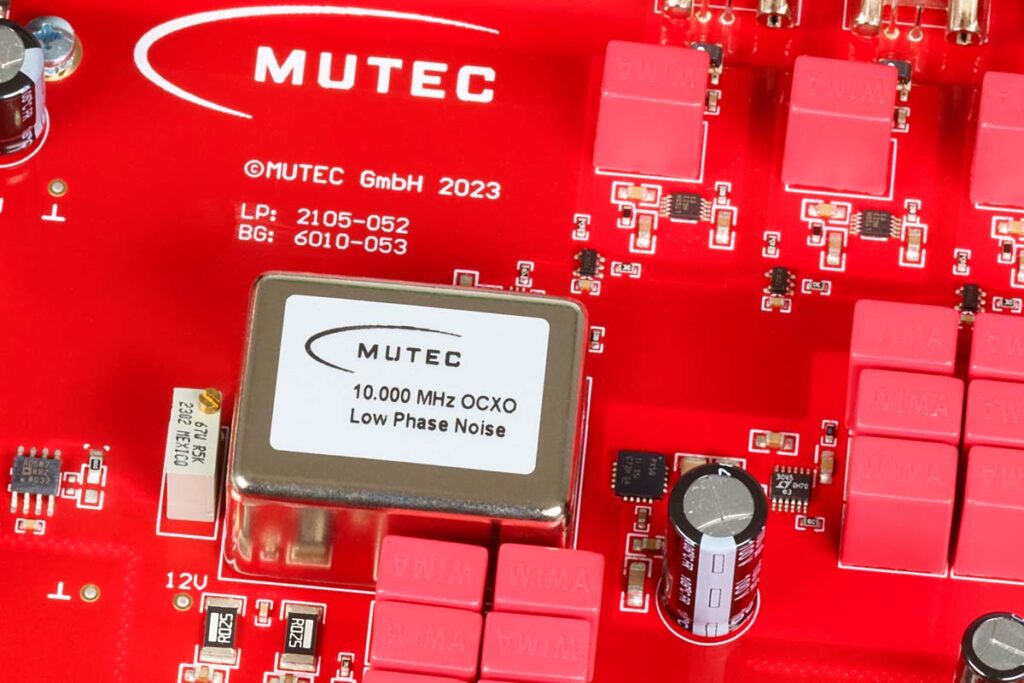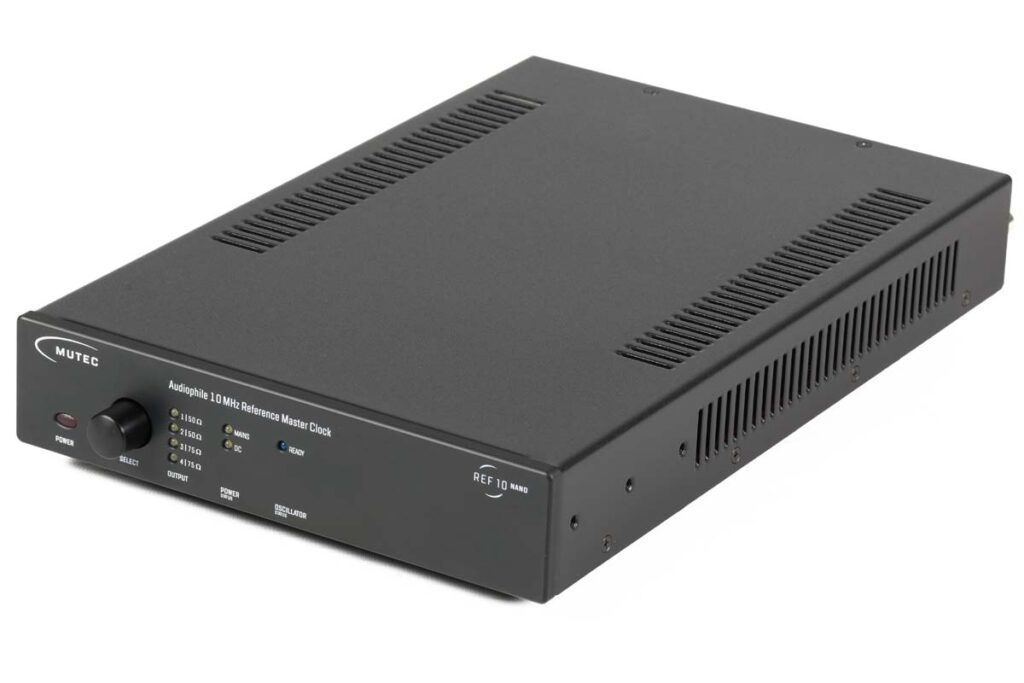The clock is one of the final blank spots on the hi-fi map: we know it exists, and we know it helps. But it remains a mystery to most users just how exactly a clock sets the rhythm, and how it can be that one clock ticks more precisely than another. These questions beg an excursion into (largely) uncharted territory.
For a deeper understanding, let’s investigate the opposite ends of the spectrum. If you pop the hood of many a CD, SACD or network player, you will discover numerous “clock generators” shimmering in silvery thermal insulation. The drive controller has one, the D/A converter may have several, serving 44.1 and 48 kilohertz plus multiples. And any DSPs and signal processors are synchronized via additional dedicated clock generators. This list reveals that enforcing synchronization between the clocks rather than dissonance is no trivial task.
Therefore, top-tier components rely on central clocks: a single high-performance clock that has a handle on every component. But don’t think that relying on a sole conductor makes these devices any less complex. After all, each and every clock has to be derived simultaneously and jitter-free. In turn, these devices play with remarkable coherence – I’ll just mention Esoteric if you need a prominent example. However, on the downside, any problems in this domain are then multiplied: a trivial “misstep” of the clock generator ultimately compounds through all components and assemblies. And this is even more crucial in studio environments, where not just one device but an entire fleet dances to the rhythm of one reference clock.
If you are wondering what would impair such a clock, it’s the “usual suspects”: Noise, temperature fluctuations, mechanical interference, resonances as well as the treacherous power supply interplay. And don’t think of such a “misstep” as the clock skipping a beat. Ideally, a clock generator should output a square-wave signal with an infinitely steep slope whose frequency corresponds to the target clock – a rock-solid 10 megahertz in the case of Mutec’s REF10 family. However, the previously mentioned influences can cause jitter. In extreme cases, the edges of the square wave deform so that the synchronized component must interpret where exactly the switching point is.
This brings us to our test candidate, which is hell-bent to deliver its 10 megahertz with exemplary consistency. The Berlin-based company produces an armada of clocks and digital tools. Three reference clocks are particularly exciting for hi-fi, each of which is based on the same structure and come in at neatly staggered prices of 2000 (REF10 Nano), 4000 (REF10) and 6000 euros (REF10 SE 120). Their range of functions is identical: an in-house clock – more on this in a moment – outputs sharp-edged signals via 50 and 75 ohm connections. The REF10 and REF10 SE 120 have eight lockable BNC outputs (2 x 50 Ω, 6 x 75 Ω each), while the Nano has two each – still more than enough for any hi-fi fleet.
Mutec’s developer and managing director Christian Peters explains that the main differences are progressively tight component tolerances and differences in the power supply unit architectures. The transformers of the two “non-Nanos” are more powerful and better shielded (electrically and spatially) from the clock generator in their larger 2U enclosures. Simultaneously, any risk of interference has also been addressed with the Nano. Unlike its larger siblings, it uses a switching power supply, which is cheaper and requires less space. To minimize interference, the circuits of the power supply unit and the clock generator, as well as those of the associated controller, are galvanically isolated from each other. If you want, you can bypass the 15-volt power supply and replace it with an external one – there is a colorful audiophile selection from brands such as sBooster and SotM. The circular DC power connection, located at the rear directly next to the IEC socket, makes the optional upgrade boost a breeze.
Peters relies on encapsulated quartz oscillators in the OCXO design (the abbreviation stands for “Oven Controlled Quartz Oscillator”), rather than one of the rubidium clocks that are all the rage these days. And there is a misconception at play here, as the developer explains: rubidium and caesium are particularly useful for long-term applications – their frequency deviations over months and years are extremely small, which explains the excellent reputation. However, music listening occurs in time intervals of a comparatively minuscule magnitude. And for consistency and jitter-free operation, a heated clock remains unsurpassed. The encapsulated quartz with “Mutec” printed on it is housed in an insulated metal casing. The surprisingly large component is manufactured by a specialist who cuts the crystals to specification and assembles them with the other ingredients to create the clock. The small quartz crystal lives with temperature sensors and a circuit that ensures a constant 80° C – the oscillator is most stable at a cozy sauna temperature. This refined clock arrangement of the REF10 Nano (it is located directly in front of the connectors) means that the flawless square-wave signals reach the four outputs without any deformation. Only four relays stand in the signal path, which can disconnect outputs that are not in use.
And this brings us to a rather exciting question: what can be done with 10 megahertz signals? A whole range of players and D/A converters can be “externally clocked” via rear inputs (usually BNC). For orientation, the Mutec homepage maintains a constantly updated list of compatible devices, including the impedances of their word clock inputs. It is worth looking at the “Description” tab of the REF10 siblings. As luck would have it, we got to enjoy several of these products, including Esoteric’s K-05XD, a Munich from Silent Angel, and the Evo DAC Two Plus from M2Tech, which became our most important partner during listening tests (mainly due to its mobility).
In fact, the large SACD player from Esoteric demonstrated a miniscule response to the connection of the external reference clock. Our first explanation was the high quality of the built-in clock generator. However, this was not necessarily the only reason. As Peters explained, some manufacturers only roughly adhere to the specifications of the word “clock standard” and use their own voltage values. This means that the pulses of a connected clock aren’t even recognized. Therefore, the RME fleet (compatible on paper) does not appear in the manufacturer’s lists. We didn’t dwell on the phenomenon for long because the Evo DAC, which is unfortunately no longer available, proved a more practical hit.
It’s not so easy to put the effect of a clock generator into words. Ideally, the effect on parameters such as the tonality or imaging depth and width of the synchronized component is zero. Instead, the musicians in an ensemble seem to concentrate on each other and better synchronize their playing together. The music is literally tied together and shifts into a more engaging context. This is most evident with just a few instruments in motion. For example, in the lively rondo of a cello sonata by Beethoven, which really began to swing over the clocked Evo. Or in Tracy Chapman’s “Fast Car” (Tracy Chapman), where the subtle yet driving sixteenth-note hi-hats came to the fore. As we are moving away from tonal aspects, the REF10 Nano is equally effective when the recording is not one hundred percent. The effect further unfolds in pop productions such as “Tonight, Tonight, Tonight” by Genesis (Invisible Touch) or in the phenomenally groovy Live At Slane Castel by the Red Hot Chili Peppers (yes, for once a DVD was involved!). This was seemingly magically livened up and blended together through the reference clock.
Above all, the fact that the clocked component remains “completely itself” makes the upgrade with a master clock one of the most worthwhile tuning approaches for me. Of course, previous reviews have proven that Mutec can coax even more out of a player’s timing with its larger siblings. However, the REF10 Nano, with its reasonable price tag, is certainly the most sensible and also the most exciting introduction to excellent high-fidelity timing. It stands as the perfect vehicle for exploring the unknown world of reference clocks.
Accompanying Equipment
CD player: Audio Note CD 3.1x, Esoteric K-05XD | Streamer/media player: Lumin X1, Aavik SD-880, Linn Klimax DSM, Silent Angel Munich | D/A converter: M2Tech Evo DAC Two Plus | Preamplifier: Electrocompaniet EC 4.8 Mk II | Integrated amplifier: Aavik I-880 | Power amplifiers: Luxman M-10x, Burmester 216, Electrocompaniet AW-800, Linn Klimax Solo | Loudspeakers: Wilson Audio Sasha DAW | Cables: Ansuz, WestminsterLab, HMS | Rack: Finite Elemente, Solidsteel
Clock generator Mutec REF10 Nano
Concept: 10 MHz reference clock generator with external upgrade power connection | Outputs: 2 x BNC (50 Ω), 2 x BNC (75 Ω) | Signal format of all interfaces: Square wave, 10 MHz, 2 Vpp, 50:50 duty cycle | Clock generation: 10 MHz low-noise oven-controlled crystal oscillator (OCXO) | Frequency stability on delivery: < ±0.01 ppm | Frequency stability in the temperature range from -20 °C to +70 °C: < ±0.03 ppm | Ageing after ten days of operation: < ±0.0002 ppm (per day), < ±0.03 ppm (first year), < ±0.2 ppm (10 years) | Warm-up time at +25 °C: < 5 min | Power consumption (operation): 7 W | Special features: Unused connections can be switched off; in-house cables available for 50 and 75 Ω connections | Finish: metal housing silver or black | Dimensions (W/H/D): 20/4/30 cm | Weight: 2.1 kg | Warranty period: 2 years | Price: around 2000 €
MUTEC GmbH
Siekeweg 6/8
12309 Berlin
Phone +49 30 7468800
contact@mutec-net.com

